

RUSSIAN SNACK MARKET STUDY
2002
This report was produced by Agriculture and Agri-Food Canada. Although every effort has been made to ensure that the information is correct, Agriculture and Agri-Food Canada assumes no responsibility for its accuracy, reliability, or for any decisions arising from the information contained herein.
Please address any comments or suggestions you have on this study to:
International Issues Team
Agriculture and Agri-Food Canada
Fax: (613) 759-7506
TABLE OF CONTENTS
Russian Consumer Attitudes Towards Snacks
Cereal-Based Confectionery Market
Factors Affecting Consumer Choice
Snack Product Range in Russian Supermarkets, Food Shops and Wholesale/Retail Markets
Russian Production Strategies REGARDING SNACK Variety and Distribution
Distribution Channels for Snacks
Executive Summary
In 2001, Russia was the world's 13th largest food importer, with agri-food imports totaling over CDN$ 15 billion. During that same year, Canadian agri-food exports to Russia totaled CDN$ 87 million, capturing only an extremely small share of the huge potential represented by this market.
The Russian snack market began to diversify as recently as 1998. Before this period, only chips and crackers had been manufactured and consumed. However, new types of snacks are now available to Russian consumers.
Recent studies have shown that snacks are bought predominantly by people under 40 years of age who earn a small to average income. The variety of snacks available on the Russian market differs from that in the Western part of the world. A consumer survey reveals that Russian consumers are not familiar with a number of snacks that are common to Europe and America. Although Russian consumers are familiar with products such as yogurt, chewing gum and cakes, they do not consider them snacks. Russian consumers group snacks in five general categories:
- Potato chips (Moscow leading the country's chip production, producing 80% of chips),
- Cereal-based snacks (including crackers, dried crusts and other microwaveable products),
- Nuts (including chocolate or yogurt coated nuts and dried fruit),
- Meat snacks (such as smoked beef shavings and dry meat snacks),
- Fish (shaved or dried or smoked pieces of fish in small packs).
Potato chips are the most popular type of snack among Russian consumers, followed by nuts and dried fruit, and then by fish snacks. In large cities, snacks in general are bought on an average of 8 times per month (96 times per year), mostly during summer time. A consumer survey showed that the respondents were according more importance on the quality of the product rather than on its price. It also determined that the quality of the packaging is an important factor in their purchasing decision.
Snacks are available in Russian supermarkets, food shops and wholesale/retail markets. In supermarkets, more than 66% of snacks are imported, in food stores, only 36% are imported, while in wholesale and retail markets this number is reduced to less than 27%.
With Canada's food safety and quality, as well as its cutting-edge technology, equipment and facilities, Canadian companies are well positioned to capture a larger share of the Russian snack market and compete against the current leading suppliers.
Introduction
This study revolves around four major market segments of the Russian snack market. These segments are as follows:
- The potato snack market
- The cereal-based or confectionary market
- The meat and fish market
- The nut and dried fruit market
This report also highlights consumer's attitudes towards snacks, the factors affecting consumer's choice on snacks, as well as the different production strategies & distribution channels. This report could provide valuable information to help Canadian agri-food companies compete with the top snack exporters to Russia such as the Europe Union and the Republic of Korea, and increase Canada's market share of the growing Russian snack food market.
A growing food sector
Before 1998, the size of the Russian snack market had never exceeded 100,000 tonnes (t). The market began to grow after a moderate decline during the 1998 crisis.
Between 1998 and 2000, the market tripled in size (from 66,000 t to 200,310 t.) This rapid growth was observed in 2001 when the market grew by 85%.
In dollar terms, the Russian snack market was estimated at 500 million USD in 2001, compared to 230 million USD in 2000.
The main factors that stimulated the snack market growth are as follows:
- The growth of the population's net income was evaluated at 6.5% in 2001. This significant increase in income has stimulated purchases of nonessential or "frill" products, including snacks;
- The fast pace of life, particularly in Moscow and St. Petersburg, also increased the use of convenience foods;
- Changes in life style, particularly among youth;
- The significant increase in activities of companies operating in the snack market;
- The growth in beer production. This sector represented 21% in 2001; production increased by 621 [M dal];
- The increase in retailing networks in Moscow and regions.
In 2001, several new market trends were observed, including increased demand in snacks [in the regions] and increased consumption of snack items such as pistachios and almonds.
Experts believe that economic growth in Russia will slow down in 2002; however, this slow-down will not affect the snack market. A 30% growth is projected for the snack market, and its market segments will grow at different rates.
For example, the demand for chips will grow at a faster rate, since well-known companies are just beginning to manufacture in Russia.
Nut products will also grow at a faster rate than other snack products.
A similar boom will be observed in the fish market segment this year, since a number of high-quality fish snacks are about to enter the market. Traditional consumers of dried and salted fish, such as "vobla" (Caspian Roach) will undoubtedly welcome these fish snacks.
Other market segments will not grow as rapidly.
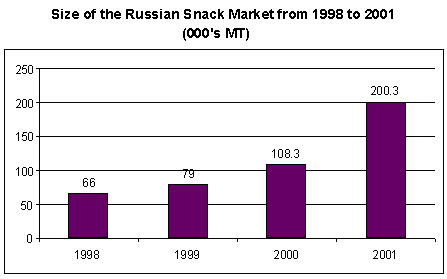
Russian Consumer Attitudes Towards Snacks
As mentioned previously, the Russian snack market began to diversify as recently as 1998. Before this period, only chips and crackers had been manufactured and consumed. However, new types of snacks are now available to Russian consumers. Snacks are predominantly bought by inhabitants of large cities. In Russia, snacks are not consumed in significant amounts. However, the second half of 2001 registered a growth in snack consumption in Russian regions.
A survey was conducted among inhabitants of large cities to determine Russian consumer attitudes towards snacks.
Despite the fact that the snack market is new to Russia, as many as 62% of inhabitants of large cities have a positive attitude towards snacks, whereas only 38% have a negative attitude.
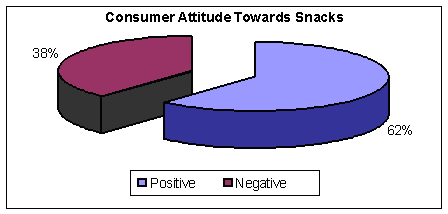
The percentage of men who like snacks is equal to the percentage of women (62%).
[Sixty-four percent of consumers under 20 years of age buy snacks; 69% of consumers between 20 and 30 buy snacks; 71% of consumers between 30 and 40 buy snacks; only 38% of consumers over 40 buy snacks.]
If one were to consider living standards, 54% of consumers with incomes of 3,000 R or less purchase snacks; 69% of consumers with incomes between 3,000 R and 6,000 R purchase snacks; only 40% of consumers with incomes over 10,000 R purchase snacks.
In conclusion, snacks are bought predominantly by people under 40 years of age who earn a small to average income.
Variety of Snacks Available on the Russian Market
The variety of snacks available on the Russian market differs from that in the Western part of the world. The survey reveals that Russian consumers are not familiar with a number of snacks that are common to Europe and America. These snacks include [corn flat cakes, dried seaweed and filling for rolls.]
Russian consumers are familiar with products such as yogurt, chewing gum, cakes, but do not consider these snacks.
The survey shows that potato chips, crackers and dried crusts are the main products to be considered snacks in the Russian market.
One can assume that corn chips as well as [potato flat cakes] would be perceived as snacks, since they are similarly to potato chips. Nevertheless, as few as [21% and 10%] of respondents perceive them as snacks, whereas [74% and 75%] disagree.
Although approximately half of respondents considered bread rolls to be a snack that required only heating, 36% disagreed.
One half of the respondents did not believe that food items such as baked products (cakes, pastries, [popcorn]) should be included in the "snack" category.
The majority of the respondents did not believe that fillings for rolls, small-size confectionery (e.g. chocolates, caramel) and jellies should be considered snacks.
As many as 76% of respondents would not consider chewing gum to be a snack. However, 19% of respondents did.
Fifty-two percent of the respondents regarded products such as dried crusts, nuts and dried fruit in small packages as snacks, whereas the other 43% and 38% did not.
Most of the respondents associated snacks with meat, and light fish meals [to be consumed with beer.]
Less than one half of the respondents perceived yogurt, nuts and fruit as snacks. However, those who conducted the survey believe that this situation can change since the demand for such products is just emerging.
| Product | Recognized as a Snack in the West | Recognized as a Snack in Russia |
|---|---|---|
| Potato chips | Yes | Yes |
| Corn chips | Yes | No |
| Potato [flat cakes] | Yes | No |
| Dried crusts | Yes | Yes |
| Salted cereal sticks | Yes | No |
| Cakes | Yes | No |
| Corn and rice cakes, [flakes], etc. | Yes | No |
| Popcorn (sweet, microwaveable) | Yes | No |
| Crackers | Yes | Yes |
| Bakery rolls (oven-baked or microwaveable) | Yes | Yes |
| [Mixtures of sprouting seeds in the form of small breads] | Yes | No |
| Nuts and dried fruit | Yes | Yes |
| Confectionery in small packs (hard - caramel, and soft - edible chewing gum) | Yes | No |
| Chewing gums | Yes | No |
| Nuts or fruit in yogurts | Yes | No |
| Smoked beef shavings | Yes | Yes |
| Dried meat snacks | Yes | Yes |
| Shavings or pieces of smoked or dried fish in small packs | Yes | Yes |
| Spicy cheese sticks | Yes | Yes |
| [Jelly] | Yes | No |
| Dried seaweed | Yes | No |
| Fillings for rolls (sweet or savoury) | Yes | No |
Based on the survey results, all products that Russian consumers regarded as snacks were grouped in the following five general categories:
- Potato chips
- Cereal-based snacks (crackers, dried crusts and other microwaveable products)
- Nuts (including ones found in chocolate or yogurt and dried fruit)
- Meat snacks (smoked beef shavings, dry meat snacks)
- Fish snacks [to be consumed with] beer (shaved or dried or smoked pieces of fish in small packs, [also spicy cheese sticks])
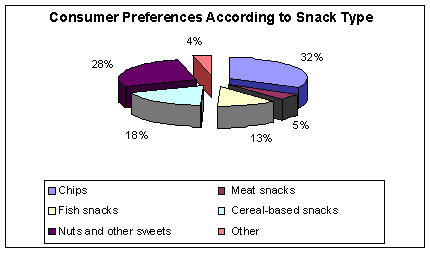
Per Capita Consumption of Snacks in 2001
In 2001, inhabitants of large Russian cities bought snacks an average of 8 times per month (or 96 times a year). The average weight of consumed snacks is 69 g. Thus, the per capita consumption of snacks in large cities is 6.6 kg.
Still, the per capita consumption of snacks in Russia, as a whole, is 4.3 times lower than in large cities. Thus, the per capita snack consumption in Russia should be 1.4 kg.
| Snack Categories | Consumption (%) |
Average per capita consumption in large cities (kg) |
Average per capita consumption in all of Russia (kg) |
Market Size (MT) |
|---|---|---|---|---|
| Chips | 34 | 2.266 | 0.471 | 68,527 |
| Meat snacks | 5 | 0.349 | 0.072 | 10,543 |
| Fish snacks | 14 | 0.872 | 0.181 | 26,357 |
| Baked rolls | 18 | 1.220 | 0.254 | 36,899 |
| Nuts and other sweets | 29 | 1.917 | 0.398 | 57,984 |
| Total: | 100 | 6.624 | 1.376 | 200,310 |
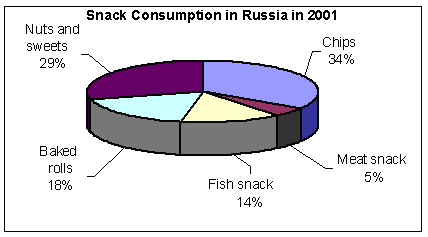
Potato chips are consumed as snacks in the largest proportion (34% of the market) since they are a traditional product in Russia. Nuts are consumed in the second largest proportion (29%), and baked rolls, including dried crusts, are consumed in the third largest proportion (18% of the market).
This year, manufacturers have observed a significant increase in the demand for almost all of these products.
Meat and fish snacks are new to Russian consumers. They consider these products to be light meals [to be consumed with] beer. Meat and fish snacks make up 5% and 14% of the market, respectively.
In 2001, the leading products, in order of growth rate were as follows: nuts (of which consumption has increased by a factor of 2.3); chips (of which consumption has doubled); meat and fish snacks (of which consumption has increased by 75% and 72.5%, respectively). Cereal-based snacks showed the weakest growth - 30%; consumption of dried crusts, however, increased by a factor of 2.5.
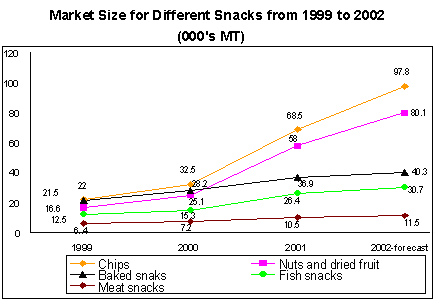
Purposes of Snack Consumption
[Forty-nine percent of respondents said they buy snacks for their own use. Ten percent buy snacks for visitors, 9% for children, and 5% buy snacks for other family members and others.]
Thirty-three percent of the respondents buy snacks to satisfy hunger. Approximately the same percentage buy snacks when they drink beer, and 23% buy snacks to satisfy a craving.

Chips are the most popular form of snack (34%); nuts and dried fruit represent the second most popular form (28%). Fewer people buy rolls and fish snacks (18% and 13%, respectively); 5% only buy fish snacks.
When looking at gender groups, one notes that men most frequently buy meat and fish snacks, whereas women most frequently buy baked rolls. In the survey, 29% of male respondents and 19% of female respondents admitted buying fish snacks. Fourteen percent of men and 5% of women buy meat snacks. Conversely, 48% of women versus 19% of men buy baked rolls.
Fifty-seven percent of men and 67% of females buy chips, whereas 48% of men and 57% of women buy nuts.
Consumers who earn a monthly income of 3,000 R mainly buy chips and rolls; consumers who earn between 3,000 R and 6,000 R buy chips and nuts. Consumers with incomes over 10,000 R buy nuts more frequently, but buy chips less frequently than any other income group.
In the under 20 age group, 64% of the respondents buy chips; in the 20 to 30 age group, 77% buy chips; in the 30 to 40 age group, 29% buy chips; and in the over 40 age group, 63% buy chips.
People between 20 to 30 years old buy nuts more frequently (77%); those under 20 years old and over 40 buy nuts less often (43% and 50%, respectively).
Fifty percent of people under 20, and 15% of people between 20 and 30, as well as 57% between 30 and 40 buy bakery snacks.
People between 30 and 40 most often prefer fish snacks (57% in this group versus 20% to 25% in other age groups).
Seasonal Pattern of Snack Consumption
The survey shows that most of the respondents buy their snacks in summertime (48%).
Half of the consumers buy their snacks in wintertime (22%), whereas 17% purchase snacks in spring and 13% in autumn.
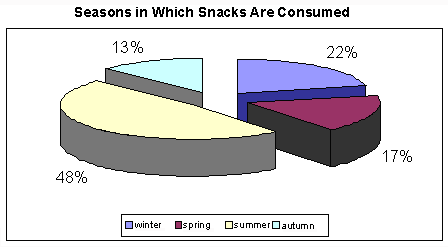
Frequency in Purchasing Snacks
Survey results show that 27% of people who live in large cities buy snacks once a week; 21% purchase snacks twice a week; another 21% buy snacks occasionally, or once a month. In addition, 17% buy snacks every day, 14% less than once a month.

Most of the consumers (62%) prefer to buy snacks packaged in small quantities of less than 100 g.

Both men and women prefer to buy snacks in small packs. However, 43% of people under 20 prefer to buy snacks in larger packs of over 100 g, whereas only 29% to 38% of people in other age groups prefer to buy snacks in larger packs. In addition, it is important to note that 55% of consumers with incomes under 3,000 R prefer to buy snacks in large packs, whereas only 30% to 40% of consumers with incomes over 3,000 R prefer to buy snacks in large packs.
Potato Chip Market
As previously mentioned, potato chips dominate the snack market. The potato chip market is developing at a faster rate than any other market.
A consumer survey shows that the main advantages of potato chips are as follows: their energy value, their ability to satisfy hunger quickly and their long shelf life. Another important advantage, according to consumers, is convenience: plates are not required to eat chips.
In 2001, the size of the Russian chip market totalled between 66,000 t and 68,500 t. Domestic production covered 60% of the demand.
Potato chip production has now doubled and totals 41,900 t. Of this amount, large factories produce 10,800 t (or 25.8%); new, smaller factories produce 74.2%.
Consumers have already expressed their preferences for brand names and kinds of chips. Most consumers are able to identify their favourite brand of chips. Twenty-three percent of survey respondents prefer ham- or bacon-flavoured chips; 22% prefer spice-flavoured chips; and 20% prefer cheese-flavoured chips.
Leaders in chip manufacturing regularly conduct market studies on consumer preferences and take their opinions into account when developing production plans. Leading manufacturers have increased their chip sales by approximately 40% to 50% during 2001.
Moscow leads the country's chip production, producing 80% of chips.
| 2001 | 2000 | 2001/2000 (%) |
|
|---|---|---|---|
| RUSSIAN FEDERATION | 10,865 | 7,839 | 138.6 |
| Moscow City | 8,730 | 5,813 | 150.18 |
| Vologda region | 1,666 | 1,549 | 107.55 |
| Voronezh region | 114 | 61 | 186.89 |
| Orel region | 93 | 105 | 88.57 |
| Novgorod region | 37 | 39 | 94.87 |
| Bryansk region | 36 | 145 | 24.83 |
| Moscow region | 36 | ||
| Omsk region | 36 | 23 | 156.52 |
| Kemerovo region | 33 | 13 | 253.85 |
| Novosibirsk region | 28 | 7 | 400 |
| Kostroma region | 15 | 9 | 166.67 |
| Vladimir region | 11 | ||
| Magadan region | 9 | 6 | 150 |
In 2000-2001, companies in other market sectors began producing chips in their factories. The number of joint-stock companies with private capital has increased significantly. The agricultural sector is also producing chips: companies that specialize in potatoes have installed chip production lines in bakeries and in confectionery factories.
Potato Chip Imports
Although domestic production of potato chips is rapidly expanding, it cannot meet the growing demand. This then leads to an increase in imports. In 2000, imports accounted for 25% of the market demand; in 2001, this number increased to almost 40%.
In 2000, 13,300 t of chips were imported; in 2001, chip imports doubled to 26,600 t.
Potato Chip Imports by Quarters
The largest amount of potato chips was imported in the third quarter of 2001: 8,800 t were imported. Imports of potato chips increased during the first three quarters of 2000, and of 2001, and dropped in the fourth quarter for both 2000 and 2001.

This is because the volume of chip imports to Russia varies with each season. Maximum quantities are imported in the 3rd quarter when potatoes are harvested in the country.
Imports decrease in the fourth quarter because consumption decreases in the autumn and winter seasons.
Supply Country
| January to November 2001 | ||
|---|---|---|
| Amount (MT) |
Total (%) |
|
| Total imports | 23,611 | 100.00 |
| Poland | 7,058 | 29.89 |
| Republic of Korea | 5,957 | 25.23 |
| Finland | 4,323 | 18.31 |
| Lithuania | 2,110 | 8.94 |
| Turkey | 1,598 | 6.77 |
| Belgium | 1,135 | 4.81 |
| Germany | 493 | 2.09 |
| Netherlands | 212 | 0.90 |
| Ukraine | 161 | 0.68 |
| Sweden | 118 | 0.50 |
| Latvia | 117 | 0.50 |
| Vietnam | 70 | 0.30 |
| Ireland | 67 | 0.28 |
| Hungary | 55 | 0.23 |
| Slovakia | 25 | 0.11 |
| United States | 22 | 0.09 |
| France | 21 | 0.09 |
| United Kingdom | 15 | 0.06 |
| Slovenia | 15 | 0.06 |
| Czech | 10 | 0.04 |
| Denmark | 6 | 0.03 |
| Ecuador | 5 | 0.02 |
| Austria | 4 | 0.02 |
| Kazakhstan | 4 | 0.02 |
| Yugoslavia | 3 | 0.01 |
| Liechtenstein | 2 | 0.01 |
| China | 2 | 0.01 |
| Italy | 1 | 0.00 |
| Iran | 1 | 0.00 |
| Estonia | 1 | 0.00 |
| Japan | 1 | 0.00 |
| Canada | 0.02 | 0.00 |
| Cyprus | 0.01 | 0.00 |
| Spain | 0.01 | 0.00 |
In 2001, Poland, the Republic of Korea and Finland were the main suppliers of chips to Russia. Together, they supplied 73.43% of the total chip imports. Only 22 kg of potato chips were imported from Canada.
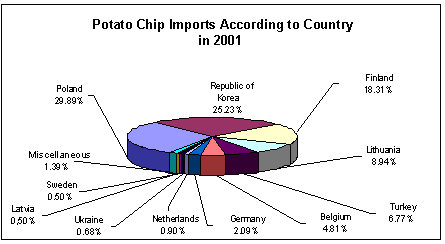
The following distributors and end buyers supplied more than 50% of the chip imports to Russia.
| Importer | Quantity (MT) |
Statistical Value (000's USD) |
Country | Total Chip Imports (%) |
Total Chip Market (%) |
|---|---|---|---|---|---|
| Frito-Lay Distribution ООО | 9,535 | 23,893 | Belgium, Hungary, Netherlands, Poland, Turkey | 35.85 | 13.91 |
| Virosko Trading House ООО | 1,338 | 485 | Republic of Korea | 5.03 | 1.95 |
| Anteks ООО | 947 | 684 | Lithuania | 3.56 | 1.38 |
| Kraft Foods ООО | 712 | 1,730 | Lithuania, Ukraine, Finland | 2.68 | 1.04 |
| Altey ООО | 662 | 330 | Republic of Korea | 2.49 | 0.97 |
| АТV-TRADE | 322 | 157 | Republic of Korea | 1.21 | 0.47 |
| ANA-TRADE ООО | 208 | 178 | Germany, EC | 0.78 | 0.30 |
| BONUSTRADE ООО | 68 | 84 | Belgium | 0.26 | 0.10 |
| SONATA ООО | 56 | 42 | Poland | 0.21 | 0.08 |
| MERIT-К ООО | 49 | 124 | Poland | 0.18 | 0.07 |
| KARDAMON АВС ООО | 46 | 61 | Germany, Poland | 0.17 | 0.07 |
| AGROALLIANS ООО | 41 | 103 | Latvia | 0.15 | 0.06 |
| STROJKA VEKA ООО | 40 | 60 | Belgium, Hungary | 0.15 | 0.06 |
| BM and Co ООО | 33 | 97 | Poland | 0.12 | 0.05 |
| PRODSERVICE-Н ООО | 29 | 28 | Poland | 0.11 | 0.04 |
| RUSSIAN BEIKLS ООО | 21 | 28 | Sweden and others | 0.08 | 0.03 |
| Total: | 14,107 | 28,084 | 53.03 | 20.59 | |
| Total imports: | 26,600 | 35,512 | 100.00 | 38.82 | |
| Entire market: | 68,527 | 100.00 |
The companies listed above are all official distributors of imported chips. Company names and their coordinates are provided below.
Survey results show that the Frito-Lay Company, which distributes the Lays trademark, led sales in 2001 with 35.9% of the market share. Russkiy Kartofel Company, a Russian potato company, which produces the Champion trademark, ranked second, with 13.4% of the market share; Estrella ranked third, with 3.1%; and Pringles (Procter&Gamble) ranked forth, with 2.9%.
Main Participants in the Potato Chip Market and in Other Snack Markets
| Name | Address, Telephone | Activity |
|---|---|---|
| NIVA AO | Ul. Alexandra Lukjanova 4, Moscow, Russia 107066 Ph: (095) 263-94-38, (095) 267-58-80 |
Production |
| BITEK Confectionary Fabric | Ul. Titova 31B, Yekaterinburg, Russia Ph: (3432) 25-79-97 |
Production of snacks |
| KOLOSS Moscow Experimental Complex of Food Products | Ul. Permskaya, vl.1, Moscow, Russia, 107143 Ph: (095) 755-84-58, Fax: (095) 167-61-58 |
Production |
| KUNTSEVO Industrial and Trading Group | Ul. Veresaeva 15, Moscow, Russia, 121357 Ph: (095) 443-06-85 |
Production |
| KRUPNO Company | Moscow, a/ya 10 Ph: (095) 721-88-64 |
Production of dried breakfast foods |
| MALAHIT | Ul. Tsentraljnaya 2, pos. Mamontovka, Pushkinskiy rayon, Moscow Oblastj, Russia, 141240 | Production |
| RIBER AND SON RUSSIA ZAO | Ul. Rabochaya 41, Elektrostal, Moscow Oblastj, Russia Ph: (09657)508-16 |
Production of potato chips |
| Russkij Kartofel (Russian Potatoes) | D. Obushkovo, P/o Pavlovskaya Sloboda, Istrinskiy Rayon,
Moscow Oblastj, Russia Ph: (095) 151-29-11 |
Production |
| RANOVA POKROVA Firm | Ul. Lenina 45, g.Pokrov, Petushinskiy Rayon, Vladimir
Oblastj, Russia Ph: (09243) 6-18-37, 6-15-61, 6-19-33, (095) 584-54-32, 584-54-79, |
Production |
| SNACK Company | Pr. Obuhovskoy Oborony 119B, St Petersburg, Russia Ph: (812) 56759-64, 567-54-35 |
Production |
| FK FINCOM ZAO | Ul. Berzarina 34, Moscow, Russia Ph: (095) 196-04-04 |
Production |
| ELIKOM Firm OOO | Kommunaljnyj Kv. 3, g. Krasnogorsk, Moscow Oblastj,
Russia Ph: (095) 777-13-33 |
Production |
| Name | Address, Telephone | Activity |
|---|---|---|
| Caravan-Product | Ul. Krasnokazarmennaya, 12, Moscow, Russia Ph.: (095) 361-94-13 |
Production, wholesaling |
| Nasha Rybka | St Petersburg, Russia Ph.: (812)-316-17-77 |
Production of fish snacks; distribution of potato chips |
| Russkie Zakuski ZAO | Ul. Architektora Vlasova, 8/1, Moscow, Russia Ph.: (095) 737-75-13, 737-75-14, 737-75-16, 737-75-19 |
Production, wholesaling |
| Sibirsliy Bereg | Ul. Yadritsevskaya, 16, g. Novosibirsk, Russia Ph.: (3832) 77-25-31 |
Production, wholesaling |
| Stavropolinvestproduct ООО | Ul. Lva Tolstogo, 39, g.Stavropol, Russia Ph.: (8652) 35-58-51 |
Production, wholesaling |
| FOOD-PLANT | Elektrichisky Per. d.8, str.5, Moscow Ph.: (095) 796-96-10 |
Production, wholesaling |
| Name | Address, Telephone | Activity |
|---|---|---|
| Allegri and Co. | Ryazanskiy Prosp. 8a, Moscow, Russia Ph.: (095) 171-99-39, 174-32-84 |
Wholesaling, distribution |
| Angstrem Trading Company OOO | Ul. Shotlandskaya 6, St Petersburg, Russia Ph.: (812) 303-93-93 |
Distribution |
| Melagro OOO | Berezhkovskaya nab., 20, Moscow Ph.: (095) 937-69-43, 937-69-14, Fax: 937-69-11 |
Chips distribution |
Main Players in the Market
In addition to the leading companies listed above, the following foreign companies are also well known to Russian consumers:
- Convent, a German company with trademarks such as Funny Frish, Сhio Chips, Truller and Wolf
- American chip companies such as Yukon Golden, Utz, Johnson Potato Farms, Crooks Farms, Sackett Ranch, Sackett Potatoes, John Boyd Co. and State Line
Imported products come from large producers and are distributed through their regional offices and distributor networks.
As mentioned above, many potato chip manufacturers have established themselves in Russia over the past two years. Chips are manufactured at small- to medium-sized production factories.
Small producers use hand-packing technologies and can produce up to 5,000 packs a day. Medium-sized producers use automatic packing technologies and can produce 5,000 to 20,000 packs per day.
Larger companies are based in Moscow and St. Petersburg. Their production capacity is over 100 kg of chips per hour. Chip factories are present in all major cities.
Potato Chips Production Technology
The technological process of roasting potato chips is simple, and 80% of the quality of the final product depends on the quality of the pellet.
In Russia, chips are manufactured on the basis of imported pellets. The main suppliers of pellets are as follows: [Italian companies "APULIAN CONSORTIAN" (manufacturer - "Spett. Lc Ditta PELLFOODS SR1"), "PAVAN" (manufacturer - "V.AL. IN."), Swiss "Balsen Snack GMBH&Cо", German "KL Radchen", Korean "K&M", Polish and Belorussian firms.]
The growing demand for potato chips in Russia has stimulated the domestic production of pellets. Ingredients used in the process, such as potato flour and potato granules, are not readily available in Russia. Therefore, they are mainly imported, predominantly from the following countries:
- [Finland; suppliers are Nordic, L.Agro companies (manufacturer is RAISIO Nordic)
- Italy, suppliers are KNORR, HELLMANNS (manufacturer is А/О CPC Foods Company Ltd.)
- USA - ORISINI M. R., Uncle Ben's,
- Germany - Gold Pure (distributors - "Sevtorgimport", "Paritet", "Degot"), "MAGGI", "ELENA", "NORDIC", "INVITE" (supplier is "Best-Foods"). ]
In Russia, semi-finished products for chip production are manufactured by small, newly established factories (e.g. a factory in the Novosibirsk region, Iskitim district, with a capacity of 225 t per year; [Bryansk region, Orel region - the Bolhovsky vegetable drying plant, Samara region - Tolljaty catering products of VAZ.] Similar factories are to be established in the Dmitrovsky and Serpuhovsky districts of the Moscow region and in other areas. However, domestically produced pellets are not available in Russia. Therefore, chips are manufactured with imported materials supplied by Belarus' Marjinogorsky potato processing plant (Marjina Gorka town, Minsk district), Usdensky plant (Uzda town of Minsk region) and by Gantsevichsky Experimental Vegetable Preserving and Drying Plant (Gantsevichi town, Brest region).
Equipment
The equipment required for pellet production is manufactured in Russia, Belarus, Switzerland, Germany, Italy and in other countries. The Arsenal factory is the Russian equipment manufacturer located in St. Petersburg. The Himmash plant, located in the city of Penza produces universal [ZF-POK], which is designed to make roasted potato products such as potato [slides], potato straw and potato sticks. In Belarus, the Beltechnoprod factory produces the equipment required for chip production.
The Swiss Buller firm is the leading manufacturer of extruders.
Pavan and Fata Group, both Italian firms, supply high-quality equipment to Russia in order to produce French fries, semi-finished products and chips. Perfi and Levati, American firms, Kiremko, a Dutch firm, and [PAUL KUNZ] also supply the equipment required for the production of chips and French fries. Sweden's Alfa-Laval supplies equipment for flakes and flour production.
Although potato chip production from semi-finished products is a new business in Russia, it is a rather simple business and is developing rapidly. The investment return period is often less than a year, and the profitability is more than 50% with a capital turnover period of 10 to 15 days. This makes the Russian potato chip market very attractive for both investors and for suppliers of materials and equipment.
Potato Chip Market Prospects
As mentioned previously, the potato chip market is developing faster than any other snack market in Russia. This explains the high level of competition between importers and domestic manufacturers. However, since Russian consumers tend to buy more Russian-made food products (rather than imported ones), the domestic production of potato chips is expected to grow.
For example, the Frito-Lay Company will begin chip production in Russia. The factory plans to produce 30,000 t of chips per year. In 1998, Frito-Lay, a member of PepsiCo holding, built a production factory in Kashira to produce Lays chips. The factory was not able to begin operations due to the August crisis. Until recently, the building had been used as a storage facility for imported products.
The project, however, which cost US$20 million, will resume. In 2001, Frito-Lay resumed its agricultural program aimed at developing raw materials. Over the next two years, two production lines, each producing 15,000 t of chips per year, will be installed in the factory.
There is a possibility that Swedish Estrella will manufacture potato chips in Russia. The company has been introducing potato cultivation technologies in the Novgorod region for three years. The Swedish company has supplied potato seeds and machinery to two private farms: SPK Iljmenj and Anatoly's Lipatov farm. At the beginning of this year, the Novgorod administration provided an additional 6,000 h to the company for potato cultivation. The company is now planning to start chip production in the Novgorod region. Basic raw material is already available.
In 2002, the Russkij Kartofelj production holding will be purchasing a chip production line in the Netherlands and will start the operation of a new production department. Modernization will cost US$2.5 million; however, this will allow sales to increase from their current US$5 million to US$7.5 million.
Cereal-Based Confectionery Market
In 2001, Russian bakeries produced 36,900 t of snacks. The snack market was estimated at 49,100 t; 43% of these were imported, and 57% were domestically produced. Exports of cereal-based confectionery food items were estimated at 12,000 t. The Commonwealth of Independent States (CIS) is the main importer of Russian cereal-based snacks.
Seventy-eight percent of consumers prefer crackers, whereas 84% prefer dried crusts. Only 47% of survey respondents consider microwaveable cereal-based products as snacks.
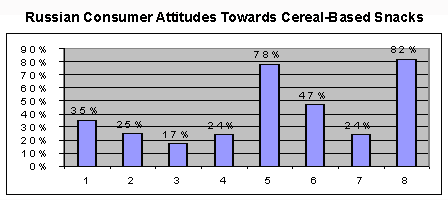
1. [Flour salted sticks]
2. Cakes and other convenience confectionery
3. Corn cakes, rice snacks, [flakes], etc.
4. Popcorn
5. Crackers
6. Microwaveable Cereal-based products
7. [Dried bread chunks]
8. Dried crusts
In Russia, the cracker industry is traditionally the most developed of all. [In 2000-01, the manufacturing of dried bread chunks with cereal seeds, as well as frozen flour semi-products designed for home preparation began to develop.]
In 2000, a new product, referred to as dried crusts, appeared on the snack market. Dried-crust snacks are exclusive to Russia since they are made with traditional Russian rye bread. This product has become one of the most popular snacks of Russian consumers. Surveys reveal that crusts are now in direct competition with potato chips. The production of dried crusts has increased dramatically.
In 2001, Russian industries produced a total of 26,750 t of rolls and cereal-based confectionery products as snacks. In comparison to 2000, the output associated to this category of snacks has increased by 6.4%, or 1,600 t.
Crackers make up 37% (or 10,000 t) of this category, dried crusts make up 50% (or 13,500 t). The amount of cereal-based [semi-finished products], [destined for home preparation], increased from 950 t in 2000 to 1,900 t in 2001.
| 2001 | 2000 | 2001/2000 (%) | |
|---|---|---|---|
| Russia's Total | 26755.0 | 25155.0 | 106.4 |
| Moscow (city) | 1581.2 | 1400.2 | 112.9 |
| Krasnodar region | 1562.3 | 1484.7 | 105.2 |
| Moscow region | 1335.8 | 1271.5 | 105.1 |
| St. Petersburg (city) | 971.3 | 885.4 | 109.7 |
| Nizhni Novgorod region | 876.9 | 837.1 | 104.8 |
| Rostov region | 814.2 | 697.3 | 116.8 |
| Sverdlovsk region | 803.2 | 729.4 | 110.1 |
| Tatarstan Republic | 768.3 | 705.7 | 108.9 |
| Chelyabinsk region | 625.8 | 556.5 | 112.5 |
| Bashkorstan Republic | 597.1 | 486.2 | 122.8 |
| Krasnoyarsk region | 591.1 | 351.3 | 168.3 |
| Samara region | 578.2 | 517.7 | 111.7 |
| Stavropol region | 541.2 | 501.0 | 108.0 |
| Perm region | 539.6 | 481.2 | 112.1 |
| Kemerovo region | 508.8 | 474.8 | 107.2 |
| Tjumen region | 499.7 | 434.4 | 115.0 |
| Volgograd region | 497.3 | 469.5 | 105.9 |
| Novosibirsk region | 466.6 | 414.2 | 112.6 |
| Tver region | 456.4 | 411.1 | 111.0 |
| Votonezh region | 445.1 | 430.3 | 103.5 |
| Saratov region | 407.8 | 393.5 | 103.6 |
| Vladimir region | 404.3 | 354.0 | 114.2 |
| Tula region | 401.0 | 392.6 | 102.1 |
| Yaroslavl region | 373.0 | 343.6 | 108.6 |
The table above shows that more cereal-based snacks are produced in highly populated urban regions; highly populated urban regions constitute markets for these products. The city of Moscow accounts for 6% of the total output, while St. Petersburg accounts for 3.6%.
Cereal-Based Snack Imports
In 2001, 60,000 t of pastries and cereal-based confectionery were imported (e.g. bread, confectionery, pastries, biscuits, wafers). However, only 35% of these were considered snacks by Russian consumers. Thus, the cereal-based snack imports accounted for 21,000 t of the total imports for 2001. In 2000, these imports were estimated at 15,600 t (or 25% less than in 2001).
Biscuits, cakes and similar products accounted for 70% of the cereal-based snack imports; semi-products accounted for 30%.
Exports of Russian cereal-based products were estimated at 35,000 t (with 12,000 t considered as snacks).
| January-September 2001 | ||
|---|---|---|
| Volume (t) | [Доля в общем объеме] (%) | |
| Total imports | 60,000 | 100 |
| Including imports from: | ||
| Bulgaria | 1,047 | 2.33 |
| Israel | 221 | 0.49 |
| Korean Republic | 4,098 | 9.11 |
| Moldova | 1,464 | 3.25 |
| Ukraine | 17,772 | 39.51 |
| Other countries | 20,384 | 45.31 |

Imports of cereal-based snacks vary with each season. More snacks are consumed during summertime. Companies that have acquired experience in the market over the years, increase their imports in the second quarter.
A decrease in imports is observed in the third quarter. This phenomenon occurs mainly because the domestic production of these products generally increases during the summertime, while consumption decreases during autumn and winter.

The following importers of cereal-based snacks accounted for 23% of imports.
| Importer | Quantity (MT) |
Statistical Value (000's USD) |
Main Suppliers | Total Cereal-Based Snack Imports, (%) |
Total Cereal-Based Snack Market (%) |
|---|---|---|---|---|---|
| "SLAIT+" ООО | 753 | 487 | Italy, Finland | 3.59 | 1.53 |
| VINJON ZAO | 741 | 302 | Germany, Poland | 3.53 | 1.51 |
| BOLSHEVIK OAO | 496 | 874 | Morocco, Poland | 2.36 | 1.01 |
| TALJVER ООО | 359 | 291 | Kazakhstan | 1.71 | 0.73 |
| ZAO Dr OETKER ZАО | 352 | 642 | Germany, Czech | 1.68 | 0.72 |
| Euro-Bakery ООО | 337 | 331 | Denmark, Italy, Netherlands | 1.60 | 0.69 |
| Miss Bonbon ООО | 240 | 130 | Germany, Denmark, Turkey | 1.14 | 0.49 |
| Moscow-McDonald's ZAО | 224 | 404 | UK, India, Ukraine, Finland | 1.07 | 0.46 |
| Globex-Land ООО | 202 | 129 | Ukraine | 0.96 | 0.41 |
| Artemida-Don ООО | 189 | 118 | Ukraine | 0.90 | 0.38 |
| Neva Chupa-Chups ZAО | 179 | 246 | Spain | 0.85 | 0.36 |
| Dukalba ZAO | 175 | 439 | Italy, Poland, other countries | 0.83 | 0.36 |
| Russkije Producty Trading House ООО | 166 | 99 | Ukraine | 0.79 | 0.34 |
| Nord-West FK ОАО | 163 | 72 | Germany, other countries | 0.78 | 0.33 |
| Frico ООО | 142 | 269 | Germany, France, Sweden, other countries | 0.68 | 0.29 |
| Mars ООО | 128 | 453 | Austria | 0.61 | 0.26 |
| Total: | 4,846 | 5,286 | 23.08 | 9.87 | |
| Total imports: | 21,000 | 100.00 | 42.77 | ||
| Entire market: | 49,100 | 100.00 |
The following importers are also large distributors of foreign cereal-based products. Their addresses and telephone numbers are listed below.
| Company Name | Address and Telephone Number |
|---|---|
| Biscuit Trading ООО | Horoshevsky Proezd, 9, k.1, office 502, Moscow Ph.: (095) 940-19-52 |
| Bona Company | Universitetsky Prospect 5, Moscow Ph.: (095) 137-72-72 |
| Russkiy Kartofelj (Russian Potatoes) |
B. Koptevsky Proezd 6, Moscow Ph.: (095) 151-04-30, 937-86-51 |
| Boni and Koms ООО | Proektiruemuy Proezd 5113, d.4, Moscow Ph.: (095) 348-22-22, 348-22-11 |
| Emelja Company | Volokolamskoye Shosse, 75, k.1, Moscow Ph.: (095) 490-61-12, 490-57-94 |
| Boralex ООО | Polessky Proezd 16, str. 2, Moscow Ph.: (095) 190-54-00, 190-36-77 |
| FK FINCOM ZAO | Ul. Berzarina 34, Moscow Ph.: (095) 196-04-06, 196-06-01 |
| El Ri Tech ООО | Ryazansky Prosp. 16, Moscow Ph.: (095)170-08-10, 174-08-78 |
| Borodino OOO | Rusakovskaya 13, Moscow Ph.: (095) 264-73-13 |
| Gorod Sladostey Company | Ul.2-ya Magistraljnaya, 16, Moscow Ph.: (095) 940-84-40 |
| Euro Bakery | Ul. 3-ya Radiatorskaya, 10, Moscow Ph.: (095) 150-11-76 |
| IMPIRE Trading House | Ul. Luzhskaya, 10, k.1, St Petersburg, Russia 195265 Ph.: (812) 596-58-58, 596-58-59 |
| KARABUS ZAO | Ul. Antonova-Ovseenko, 15, str. 1, oiffice 211, Moscow
Ph.: (095) 256-66-24 |
| Candy Trio OOO | Moscow, Ph.: (095) 532-53-52, 532-06-59, 531-28-94, 459-77-93, 459-71-49 |
| CLUB-PRODUCT 1Х1 ООО | Ul. Krylatskaya 10, cottage No 1, Moscow Ph.: (095) 141-90-41 |
| Conditerskie Izdeliya ООО | Kochnovskiy Proezd 4, Moscow, Ph.: (095) 784-72-92 |
| Lakonia ХХI | Automobilny Proezd d. 10a, str. 8, Moscow |
| Millfoods Limited ZAO | Berezhkovskaya Naberezhnaya, 20, Moscow Ph.: (095) 937-69-43 |
| ORIANT OOO | Lomonosovskiy Prosp., 25, Moscow Ph.: (095) 939-28-79 |
| R.S.K.Center ZAO | B. Koptevsliy Proezd 6, Moscow, 125319 Ph.: (095)151-04-30, 151-07-11, 937-8651, 937-8654, 937-8655, 937-8656 |
| Techno-Trade | Altufjevskoye Shosse 27, Moscow Ph.: (095) 903-37-08 |
| Torgservice | Yaroslavskoye Shosse 2B, Moscow Ph.: (095) 424-77-42 |
| FOZZI-EURASIA ZAO | Ul. 4-y Syromyatnichesky Pereulok, 1/1, Moscow Ph.: (095) 916-10-12 |
| Company Name | Address, Telephone |
|---|---|
| Baltiysky Dom | Moscovsky Prospect, 183, g.Kaliningrad, Russia 236001
Ph.: (0112)463588 |
| Biscuit Trading OOO | Horoshevsky Proezd 9, k.1, office 502 Ph.: (095) 940-19-52 |
| BONA Company | Universitetsky Prosp. 5, Moscow Ph.: (095) 137-72-72 |
| Boni and Koms OOO | Proektiruemy Proezd, 5113, d.4, Moscow, Ph.: (095) 348-22-22, 348-22-11 |
| Boralex OOO | Polesskiy Proezd, 16, str. 2, Moscow Ph.: (095) 190-54-00, 190-36-77 |
| Gorod Sladostey Company | Ul. 2-ya Magistraljnaya 16, Moscow Ph.: (095) 940-84-40 |
| Good Food Company Group | Pevchesky Per., 4, Str.1, Moscow Ph.: (095) 298-53-16 |
| Karabus ZAO | Ul. Antonova-Ovsienko, d.15, str.1, office 211, Moscow Ph.: (095) 256-66-24 |
| Candy Trio OOO | Moscow Ph.: (095) 532-53-52, 532-06-59, 531-28-94, 459-77-93, 459-71-49 |
| Club-Product 1Х1 ООО | Ul. Krylatskaya 10, cottage No 1, Moscow Ph.: 141-90-41 |
| Konditerskie Izdelija ООО | Kochnovsky Proezd 4, Moscow Ph.: (095) 784-72-92 |
| Lakonia ХХI | Automobiljny Proezd 10a, str. 8, Moscow |
| Majestic Trading Company OOO | Danilovskaya Naberezhnaya 6/7, Moscow |
| Millfoods Limited ZAO | Berezhkovskaya Nab., 20, Moscow Ph.: (095) 937-69-43 |
| Oriant OOO | Lomonosovsky Prosp. 25, Moscow Ph.: (095) 939-28-79 |
| Riber and Son ZAO | Ul. Rabochaya 41, g. Electrostal, Moscow Oblast, Russia Ph.: (09657) 508-16 |
| Ruzanna Confectionary Fabric | Groholjsky Per. 32, office 402, Moscow Ph.: (095) 280-86-28 |
| Russkie Zakuski ZAO | Ul. Arhitectora Vlasova 8/1, Moscow Ph.: (095) 737-7513, 737-7514, 735-75, 735-7516, 735-7519 |
| Russkie Producty TD | Varshavsky Proezd 4a, Moscow Ph.: (095) 777-11-99 |
| Techno-Trade | Altufjevskoe Shosse 27, Moscow Ph.: (095) 903-37-08 |
| TORGSERVICE | Yaroslavskoe Shosse 2B, Moscow Ph.: (095) 424-77-42 |
| Florin | Ul. Kotlyakovskaya 3, Moscow Ph.: (095) 745-54-15 |
| FOZZI-EURASIA ZAO | 4-y Syromjatnichesky Per. 1/1, Moscow Ph.: (095) 916-10-12 |
Nut and Dried Fruit Market
Today, most nut and dried fruit snacks (excluding sunflower seeds and cedar nuts) are manufactured [based on what is imported.] More than one hundred Russian companies process and pack nuts. These companies are considered end producers despite their importing activities.
There are several kinds of nuts:
- Salted nuts
- Sugar-coated nuts
- Chocolate- or yogourt-coated nuts
In 2001, Russia imported 175,000 t of various nuts and dried fruit. Sixty-five per cent of these were used in confectionery industries for manufacturing. A survey reveals that Russian consumers do not regard confectionery products as snacks. However, 35% (or 60,000 t) of imported nuts and dried fruit were used in snack production.
In addition, approximately 7,000 t of nuts and dried fruit were also exported in 2001 [to be processed into snacks.] It is important to note that only value-added nuts and fruit are exported. Russian industries produced only 3,700 t of nut and dried fruit snacks, which represents 5.7% of the total market for these products. The remaining 94.3% was imported.
Nut and Dried Fruit Imports
| January-September 2001 | ||
|---|---|---|
| Volume (MT) |
Total (%) |
|
| Total imports | 175,200 | 100 |
| including imports from | ||
| Argentina | 1,845 | 1.05 |
| Azerbaijan | 1,160 | 0.66 |
| Brazil | 1,619 | 0.92 |
| Georgia | 1,090 | 0.62 |
| Iran | 10,473 | 5.98 |
| China | 25,307 | 14.44 |
| Tajikistan | 23,494 | 13.41 |
| Turkey | 8,916 | 5.09 |
| Uzbekistan | 9,652 | 5.51 |
| South Africa | 1,390 | 0.79 |
| Other countries | 90,254 | 51.51 |


The following Russian distributors of nuts and fruit are currently active in the market. These companies distribute about 20% of the imported nuts and fruits.
| Distributor Name | Quantity (MT) |
Statis tical Value (000s USD) |
Main Suppliers | Total Nut Imports (%) |
Total Nut Market (%) |
|---|---|---|---|---|---|
| MARS ООО | 4,071 | 4077 | Argentina, India, China, Indonesia, USA, Turkey | 6.64 | 6.26 |
| Rastelprom OOO | 1,740 | 635 | Iran, USA | 2.84 | 2.68 |
| Marygrik OOO | 1,502 | 521 | Iran | 2.45 | 2.31 |
| [НЕNВОR"JОINТ-SТОСК СО.] | 1,396 | 291 | China | 2.28 | 2.15 |
| RIMIST ООО | 698 | 130 | Vietnam | 1.14 | 1.07 |
| RUSSIA Confectionary Association OOO | 614 | 1755 | Azerbaijan, China, USA, Turkey | 1.00 | 0.94 |
| Constanta Investgarant OOO | 522 | 147 | China | 0.85 | 0.80 |
| Albim OOO | 397 | 125 | Argentina, and others |
0.65 | 0.61 |
| Capital Export OOO | 396 | 67 | China | 0.65 | 0.61 |
| Krasny October Moscow Confectionary Fabric OAO | 301 | 666 | Argentina, China, Turkey | 0.49 | 0.46 |
| Babaevskiy Confectionary Concern OAO | 221 | 707 | Azerbaijan, India | 0.36 | 0.34 |
| Toisan OOO | 201 | 80 | India, USA, and others | 0.33 | 0.31 |
| Rostokino GUP | 150 | 44 | Uzbekistan | 0.24 | 0.23 |
| Confi Firm OAO | 140 | 138 | China, Turkey | 0.23 | 0.22 |
| Rot Front OAO | 139 | 455 | Brazil, Turkey, and others |
0.23 | 0.21 |
| Cadbury OAO | 117 | 475 | USA | 0,19 | 0,18 |
| Total: | 12,605 | 10313 | 20,55 | 19,39 | |
| Total Nuts and Fruit Imports: | 61,338 | 100,00 | 94,37 | ||
| Total Imports Resources: | 65,000 | 100,00 |
The table below highlights the main importers of nuts and fruit to Russia. Together, these companies supply approximately 27% of nut and fruit imports.
| Distributor Name | Quantity (MT) |
Statistical Value (000s USD) |
Main Suppliers | Total Imports (%) |
Total Nut and Fruit Market (%) |
|---|---|---|---|---|---|
| Iran N ZAO | 4,992 | 1091 | Iran, Turkey, France | 8.14 | 7.68 |
| Rostokino GUP | 2,648 | 421 | Tajikistan | 4.32 | 4.07 |
| DAIR OOO | 2,363 | 371 | Iran | 3.85 | 3.64 |
| IRRUS zao | 2,153 | 446 | Iran, Turkey, France | 3.51 | 3.31 |
| Ljubistock OOO | 742 | 103 | Tajikistan | 1.21 | 1.14 |
| SAPRAIS ZAO | 700 | 245 | Afghanistan | 1.14 | 1.08 |
| Lemar-Trade OOO | 588 | 246 | Tajikistan, Uzbekistan | 0.96 | 0.90 |
| Zafar-N OOO | 450 | 158 | Afghanistan | 0.73 | 0.69 |
| Dorukhshan OOO | 400 | 140 | Afghanistan | 0.65 | 0.62 |
| VAFA Wolesale Firm OOO | 385 | 73 | Iran | 0.63 | 0.59 |
| Eksima ZAO | 193 | 336 | Yugoslavia | 0.31 | 0.30 |
| Cargo Production and Commercial Firm OOO | 184 | 35 | Iran | 0.30 | 0.28 |
| Mazand PKF OOO | 165 | 39 | Iran | 0.27 | 0.25 |
| Baltic Commerce ZAO | 146 | 73 | Netherlands, USA, France | 0.24 | 0.22 |
| Ailin TOP OOO | 134 | 43 | Turkey | 0.22 | 0.21 |
| Faez ZAO | 100 | 35 | Afghanistan | 0.16 | 0.15 |
| Total: | 16,343 | 3855 | 26.64 | 25.14 | |
| Total Nuts and Fruit Imports: | 61,338 | 100.00 | 94.37 | ||
| Total Imports Resources: | 65,000 | 100.00 |
Main Players in the Russian Nut and Dried Fruit Market
| Company Name | Address, Telephone | Activity |
|---|---|---|
| Vigado OOO | Ul. Buhvostova 12/11, Moscow Ph.: (095) 962-01-31, 962-04-33 |
Production and distribution of cedar nuts |
| DIAL TPO OOO | Ul. Ilimskaya, d.7? Moscow Ph.: (095) 409-45-11 |
Production |
| Zolotye Kupola Fabric | Pos. VNIISSOK, str. 30, Dubkovskaya P/O, Odintsovskiy
Rayon, Moscovskaya Oblast Ph.: (095) 933-24-30 |
Production |
| IMPIRE Trading House | Ul. Luzhskaya 10, k.1, St Petersburg 195265 Ph.: (812) 596-58-58, 596-58-59 |
Production |
| Corona V.A. Firm | Ul. Scherbakovskaya 53, Ph.: (095) 365-00-96 | Production |
| Meridian Plus OOO | Signaljny Proezd 35, Moscow Ph.: (095) 742-79-16 |
Production |
| MIVIMEX | Ul. Promyshlennaya 11, Office 304, Moscow Ph.: (095) 231-38-48 |
Production |
| MOSCOW NUTS COMPANY ZAO | Ul. Decabristov 51, Moscow Ph.: (095) 231-38-16 |
Production |
| PROZIMA Company ZAO | Ul. Brullova ^a, Novosibirsk Ph.: (3832) 106-306, 478-815, 478-254 |
Production |
| TROLL Company | Mozhajskoe Shosse d.25, office 310, Moscow Ph.: (095) 443-46-35 |
Production |
| FK FINCOM ZAO | Ul. Berxarina 34, Moscow Ph.: (095) 196-04-04 |
Production |
| Company Name | Address, Telephone | Activity |
|---|---|---|
| Angstrem Trading Company OOO | Ul. Shotlandskaya 6, St Petersburg Ph.: (812) 303-93-93 |
Production and exclusive distribution of products under Angstrem trademark |
| Caravan-Product | Ul. Krasnokazarmennaya 12, Moscow Ph.: (095) 361-94-13 |
Production, wholesaling |
| Manhattan-M Trading House OOO | Ul. Bozhenko 9, str. 2, Moscow Ph.: (095) 417-14-44 |
Production, distribution |
| Natural Products | Rubtsovskaya Naberezhnaya 3, office 803 Moscow Ph.: (095) 263-04-39 |
Production, distribution |
| Riber and Son Russia ZAO | Ul. Rabochaya 41, g. Electrostal, Moscovskaya Oblast Ph.: (09657) 508-16 |
Production, distribution |
| Russkie Zakuski ZAO | Ul. Architektora Vlasova 8/1, Moscow Ph.: (095) 737-75-13, 737-75-14, 737-75-16, 737-75-19 |
Production, wholesaling |
| Sibirskiy Bereg | Ul. Yadritsevskaya 16, g.Novosibirsk, Russia Ph.: (3832) 77-25-31 |
Production, wholesaling |
| Stavropolinvestproduct OOO | Ul. Lva Tolstogo 39, g.Stavropol, Russia Ph.: (8652) 35-58-51 |
Production, wholesaling |
| Food-Plant | Elektricheskiy Per. 8, str. 5, Moscow Ph.: (095) 796-96-10 |
Production, wholesaling |
| Company Name | Address, Telephone | Activity |
|---|---|---|
| Baltic House | Moscovskiy Prospekt 183, g.Kaliningrad 236001 Ph.: (0112) 463-588 |
distribution |
| Good Food Companies Group | Pevchesky Per., 4, str. 1, Moscow Ph.: (095) 298-53-16 |
supply |
Meat and Fish Snack Market
In 2001, the total meat snack market was estimated at 26,400 t; the fish snack market, at 10,500 t.
Almost all meat snacks are imported from the United Statets. These products are referred to as "vacuum-packed products."
Fish snacks are domestically produced mainly in the Far East of the Russian Federation and in the city of St. Petersburg.
Factors Affecting Consumer Choice
A survey was conducted among consumers to determine the factors that affect their purchasing decisions.
Results show that 33% of respondents placed more importance on the quality of the product, whereas 5% placed more importance on the price. However, most of the respondents (62%) stated that both price and quality were equally important.

Quality was rated as more important by 45% of respondents earning less than 3,000 R a month, by 19% of respondents earning between 3,000R and 6,000 R, and by 80% earning over 10,000 R. Conversely, quality and price were rated equally important by 45% of respondents earning less than 3,000 R, by 77% of respondents earning between 3,000R and 6,000 R and by 20% of respondents earning over 10,000 R.
Thirty-eight percent of consumers are willing to buy a snack if it costs less than 10 R; 48% are willing to buy a snack if it costs less than 50 R; and only 14% are willing to buy a snack if it costs over 50 R.
Fifty percent of consumers under 20 years old and 50% of consumers over 40 years old are willing to buy a snack if it costs less than 10 R. Similarly, 23% of consumers between 20 and 30, and 29% of consumers between 30 and 40 are willing to buy a snack if it costs less than 10 R. The price of a snack is a [critical point] for 45% of consumers earning less than 3,000 R and for 42% of consumers earning between 3,000 R and 6,000 R a month.
Thirty-six per cent of the respondents under 20 years old, 77% of respondents between 20 and 30 years, 29% of respondents between 30 and 40, and 37% of respondents over 40 are willing to pay 50 R for a snack. If one looks at income, 37% of consumers earning 3,000 R a month and 54% earning between 3,000 R and 6,000 R, as well as 20% of consumers earning over 10,000 R are willing to pay 50 R for a snack.
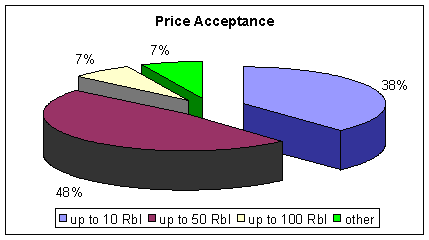
Based on the survey, it can be concluded that the higher the consumer's income, the more the consumer is willing to pay to purchase the product. It can also be concluded that young people are more interested in buying cheaper products.
The survey also shows that 55% of consumers consider the quality of packaging as an important factor in their purchasing decision.
Seventy-one per cent of respondents under 20 years old stated that packaging was an important factor. In all other age groups, as many respondents stated they paid attention to the packaging as those who stated they were indifferent. It is important to add that 73% of respondents earning less than 3,000 R frequently pay more attention to packaging versus 40% to 50% of those with higher incomes.

Nineteen percent of respondents prefer snacks that are domestically produced; 26% prefer imported snacks. Fifty-five percent, however, are indifferent as to the product's country of origin.
The majority of those under 20 years old prefer imported snacks. Other factors more greatly influence consumers from other age groups.

Snack Product Range in Russian Supermarkets, Food Shops and Wholesale/Retail Markets
In supermarkets, the proportion of cereal-based snacks and potato chips is greater than any other type of snack. This is also true in food stores (see diagram below).
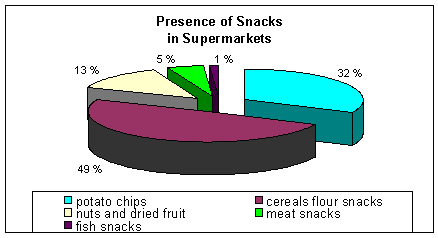
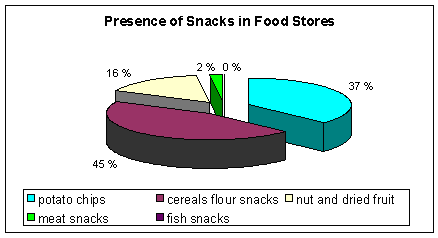
In wholesale and retail markets, the proportion of nuts and dried fruit (36%) is greater than any other snack.
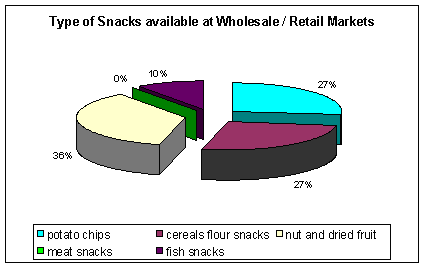
With respect to origin, 66% of snacks available in supermarkets are imported; only 34% are produced domestically.

In food stores, only 36% of snack products are imported, whereas 64% are produced domestically. It is important to note, however, that the number of snack products available in supermarkets is twice that of an average food store.

Similarly, 63% of snack products are produced domestically in wholesale and retail markets.
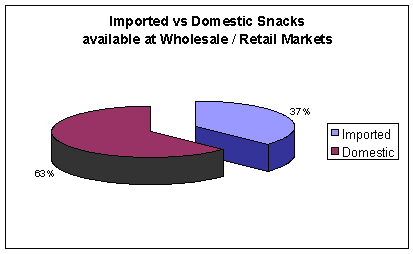
Snack Variety
There is a wider variety of potato chips in supermarkets, where one can find up to 10 different brand names. Fourteen percent of chips are domestically produced; 86% are imported. Imported products available in supermarkets predominantly come from Poland, Belgium, Sweden, Hungary, Lithuania, Finland, Ukraine and Austria.
In food shops and wholesale/retail markets, one can find five to six different brands of potato chips. In food shops, 69% of potato chips are imported from Poland or Sweden. At wholesale/retail markets, 82% of chips are imported predominantly from Poland, Lithuania, Belgium and Sweden.
There is also a wider variety of cereal-based snacks (approximately 15 brand names) in supermarkets. Sixty-six percent of cereal-based snacks are imported from Finland, Greece, Germany, the Czech Republic, the United Kingdom, the Netherlands, the Republic of Korea and Italy.
In food shops and wholesale/retail markets, five to six brand names of cereal-based snacks are now available. The majority of these are produced domestically (89% and 73%, respectively). In food shops, cereal-based snacks are mainly imported from Finland and Denmark; in wholesale/retail markets, from Poland, Finland and the Republic of Korea.
Nuts and dried fruit are available in a broader product range in wholesale/retail markets, than in any other kind of retailing outlet. Approximately 80% are produced in Russia; the rest are imported. Nuts available at wholesale/retail markets are imported from Vietnam and Italy.
On average, one can find four brand names in supermarkets and only two brand names in food shops. These products are usually imported from Switzerland and Italy.
Meat snacks are more broadly represented in supermarkets (approximately three brand names). Meat snacks are usually imported from the United States.
In the research, only one kind of meat snack could be found (on average) in food stores. This meat snack is usually produced domestically. No meat snack could be found at the wholesale/retail markets visited.
There were two brands of fish snacks found in the wholesale/retail markets, and only one in supermarkets. All were produced in Russia.
Snack Prices
| Type of Snack | Prices in supermarkets (R per kg) |
Prices in food shops (R per kg) |
Prices at wholesale/retail markets (R per kg) |
|
|---|---|---|---|---|
| Potato chips | domestic | 140.00-196.00 | 99.00-200.00 | 84.70-120.00 |
| imported | 161.00-444.00 | 193.00-317.00 | 211.00-367.00 | |
| Cereal-based chips | domestic | 42.00-133.00 | 40.00-113.00 | 40.00-139.00 |
| imported | 124.00-768.00 | 129.00-165.00 | 83.00-131.00 | |
| Nuts and dried fruit | domestic | 50.00-725.00 | 55.00-850.00 | 55.00-850.00 |
| imported | 429.00 | 250.00 | 60.00-250.00 | |
| Meat snacks | domestic | - | 360.00 | - |
| imported | 552.00-1,369.00 | - | - | |
| Fish snacks | domestic | 1,340.00 | - | 267.00-1,000.00 |
| imported | - | - | - | |
Russian Production Strategies REGARDING SNACK Variety and Distribution
The survey on large-scale Russian companies that produce and/or sell snacks reveals that large-scale producers prefer to sell their products to authorized distributors through their regional representatives. However, more financial resources are required when dealing with distributors rather than with wholesalers.
When a company first enters the snack market, it is preferable that the company work through both distributors and wholesalers.
At a later stage, companies begin to broaden their range of snacks by producing more varieties and buying snacks from other producers. Well-known Russian snack producers such as Zolotye Kupola, Imperia Trading House and Fincom ZAO currently use this strategy.
Similarly, wholesaling companies wish to become distributors for domestic and foreign producers alike.
Recently, Russian companies have shifted to a more aggressive marketing strategy. They are now promoting their products in foreign markets, such as Ukraine and Belarus. This market expansion is accompanied by a growth in snack production.
Despite the great number of snack producers already present in Russia, new players are still entering the market (e.g. Naka Berry). This company had to lower the price of its products in order to penetrate the market.
Some companies also operate their own delivery system in order to accommodate their clients. Emelja, the Russian leader in dry crust snack production, is one of many companies that operates its own delivery system.
Companies are currently paying more attention to marketing. They carry out advertising campaigns using television and other mass media. Russian snack producers are also participating in food exhibitions held in Russia.
The advertising budget for the snack industry has grown by 260% in 2001 (from 18.5 million in 2000 to 67 million in 2001). The entire Russian advertising market has grown by 54%.
[All points discussed above can be associated with particular examples of strategies employed by Russian snack companies.]
Allegri Co.
Allegri Co. is a large-scale wholesale company that imports snacks and distributes them in Russia.
The company offers a wide range of snacks such as potato chips and dried crusts, and other products such as popcorn. It buys its snacks from domestic suppliers and from foreign suppliers in countries such as Poland, Finland, Lithuania, Ukraine, South Korea, Germany, Belgium and Turkey. Some producers believe the company acts as an exclusive distributor for Lux (Ukraine) and Paldo (Republic of Korea). Still others believe it is a large-scale wholesaler distributing products from Estrella (Sweden), Lays (USA) and Super-Chips (Russia).
The company conducts an aggressive advertising campaign on Russian television and on the Internet.
The price of their snacks varies depending on the volume purchased by shops and wholesalers.
Nasha Rybka Company ([Our Fish])
Nasha Rybka is a wholesaler and also a major producer of fish snacks. In order to diversify its product range, it purchases large volumes of other types of snacks: potato chips, dried crusts and nuts.
Their products are then sold as follows:
- Through retailing networks in the city of production (St. Petersburg)
- Through small wholesalers
- Through distributors in other Russian cities
Snack buyers can either purchase their products themselves or have the company deliver to them. The price of the merchandise varies for each type of buyer listed above. Large-scale wholesalers and distributors are given small discounts, while shops pay 15% to 20% more than the price set for small-scale wholesalers. The company also provides its partners with necessary documents regarding safe storage and handling instructions.
In Moscow, Nasha Rybka deals with several large wholesalers and owns its own warehouse. In each region, it collaborates with a single partner who provides the company with advertising materials and helps it conduct advertising campaigns.
Fincom ZAO company
This company is a Russian snack producer. It supplies a wide range of products including dry crusts and rolls ["Finnat"], as well as a number of nuts and fruit products such as peanuts, almonds, pistachios, cedar seeds and [forest nuts].
Prices for dried crusts average US$2.39 per kg; rolls average US$1.20 per kg; peanuts average US$2.24 to US$3.71 per kg; and prices for other nuts average US$4.99 to US$6.43 per kg.
Fincom grants small discounts to attract buyers:
- A 0.5% discount for orders over US$50,000
- A 0.5% discount for buyers who deliver their products from the warehouse themselves
- A 1.5% for prepaid orders
The company also provides free delivery within Moscow.
Snack Company
This company provides potato chips in a variety of flavours (cheese, bacon, onion, capsicum) as well as in a variety of shapes (tubes, waves, sheets, and rings).
Prices vary between US$2.46 per kg to US$6.20 per kg.
The company conducts an aggressive advertising campaign and includes lottery cards as prizes in their products.
Distribution Channels for Snacks
Domestic Production
In Russia, local companies use three distribution methods:
- Using their own distributors
- Selling directly from warehouses
- Opting for a cash and carry system for small companies
Selling directly from warehouses is most common and accounts for 50% of the sales. Alleri Co., Fincom, Nasha Rybka and others use this method.
Approximately 30% of the sales are made trough distributors. Nasha Rybka has created a system of distributors in different regions of Russia.
The cash and carry option accounts for approximately 20% of sales. Fincom, for example, uses this system.
Channels of Distribution for Domestically Produced Snacks

Imports
Imported snacks are distributed through the following channels:
- Through distributors having their own warehouses
- Through representatives of foreign companies
- Through export associations
As of the beginning of 2002, the most widespread form of imported snack distribution is through distributor networks that have their own warehouses. Fifty percent of imported snacks are distributed through this channel.
Approximately 30% of imported snacks are sold through export associations; 20% or less are sold by affiliates.
Distribution Channels for Imported Snacks

Government Regulations for Snack Imports
Snack imports are currently regulated by customs tariffs.
| Code | Product | Custom tariff |
|---|---|---|
| 08 | Edible nuts and fruit; citrus peels or melon rinds | 5% of the customs value |
| 0811 | Fruit and nuts,[ heated or not heated in boiling water or steamed, frozen, with or without sugar or other sweeteners | 10% of the customs value |
| 0813 | Dried fruit, [but without the items 0801-0806]; mixtures of nuts or fruit of this category | 10% of the customs value |
| 11 | Flour and [groats] industry products: malt, starch, [inulin], wheat gluten | 10% of the customs value |
| 12 | Oil seeds and fruit; other seeds, fruit and grains; medical herbs and plants for processing; straw and forage | 5% of the customs value |
| 19 | Ready-made products from cereals grains, flour, starch or milk; cereal-based confectionery | 15% of the customs value |
| 1905 | Bread, cakes, biscuits and other cereal-based confectionery products with or without cacao; wafer sheets, [empty capsule for pharmacology, wafers for closing in,] rice paper and other similar products | 15% of the customs value, but not less then 0.15 EUR per kg |
| 0210 | Meat and meat edible offal salted, in brine, dried or smoked; edible wheat from meat and meat offal | 15% of the customs value, but not less then 0.4 EUR per kg |
| 0305 20 000 0 | Fish liver, caviar and soft roe dried, smoked, salted or in brine | 20% of the customs value. The tariff is valid until June 30, 2002 inclusive |
| 20 | Processed products from vegetables, fruit, nuts and other parts of plants | 15% оf the customs value, but not less than 0.075
EUR per kg The tariff is valid until June 30, 2002 inclusive |
Conclusion
Between the year 1998 and 2000, the Russian snack market tripled in size, growing from 66,000 tons to 200,310 tons. In dollar terms, this market was estimated at 760 million CDN in 2001, compared to 350 million CDN in 2000. Therefore, it is no coincidence that, since February 2002, the Russian snack market has become an emerging priority market for Agriculture and Agri-Food Canada and, simultaneously, a very attractive market encompassing many trade opportunities for Canadian food and agricultural companies.
| Date Modified: 2003-07-04 | Important Notices |